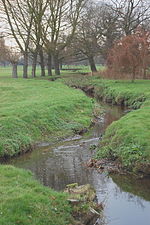Wallasea Wetlands

Wallasea Wetlands is a reclaimed wetlands area located in Essex, England. It has been created as part of a government-funded wetlands scheme to halt the decline of wild and endangered birds caused by the drainage and development of former wetland sites. It is the largest man-made marine wetland area in the United Kingdom. The wetland spans an area of 115 hectares (1.15 km2) and is sited on Wallasea Island, which borders two rivers (River Crouch to the north and River Roach to the south-east). They provide winter grounds for wading birds, as well as breeding and nursery areas for aquatic wildlife, such as bass, mullet, flatfish and herring and even some types of dolphin. The area will also help to reduce the flooding of properties near the River Crouch by providing a run-off area for floodwaters. In the process being termed "managed re-alignment", the seawall that protects croplands and property was re-established in more tenable positions, three miles behind the new wetlands, which will provide habitat for birds like oystercatchers, avocets and little terns, according to the press release issued at the time. Walkers and birdwatchers will be able to enjoy the scenery by means of a new footpath that has been built on the top of this new relocated sea wall. Construction was completed in 2006 and by 2011 the land had evolved into wetland, mudflats, saline lagoons and seven artificial islands, allowing the wildlife to reside on these areas. An extension to the scheme, using 2,400 shiploads of spoil excavated from London's Crossrail tunnels, was completed in July 2015, when an additional area of land was opened to tidal flow. This has formed the Jubilee Marsh (160 ha / 400 acres). The whole project is expected to be completed by 2025.
Excerpt from the Wikipedia article Wallasea Wetlands (License: CC BY-SA 3.0, Authors, Images).Wallasea Wetlands
Allfleets Marsh Trail, Essex
Geographical coordinates (GPS) Address Nearby Places Show on map
Geographical coordinates (GPS)
| Latitude | Longitude |
|---|---|
| N 51.6144 ° | E 0.8542 ° |
Address
Allfleets Marsh Trail
Allfleets Marsh Trail
CM0 8AX Essex, Canewdon
England, United Kingdom
Open on Google Maps









